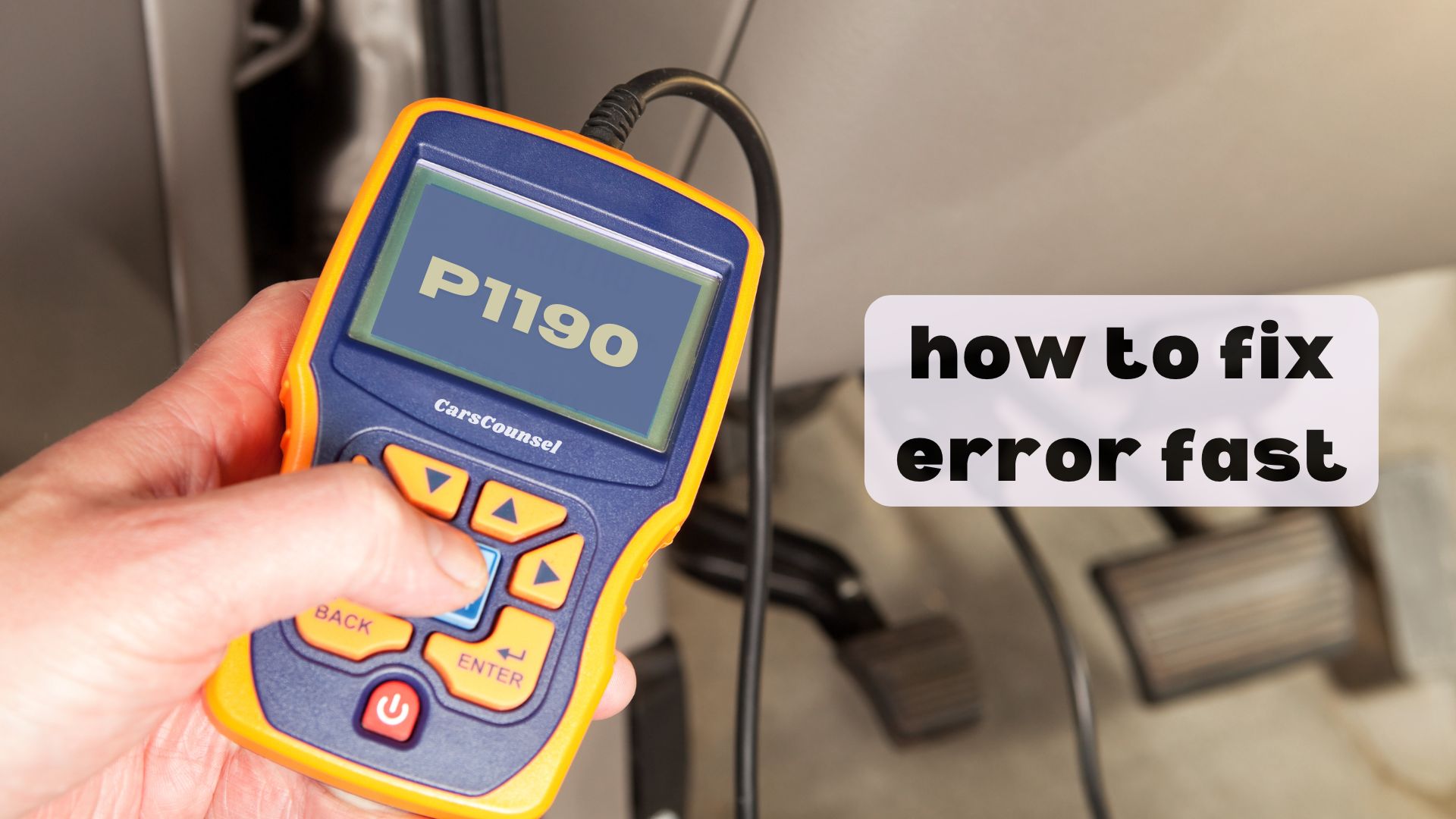When your car’s onboard computer stores a P1190 code, it’s trying to tell you something’s amiss with the intake throttle actuator. This critical component regulates airflow into the engine, and a malfunction can cause frustrating performance issues.
You might’ve noticed hesitation, stalling, or reduced power when accelerating – but what’s behind these symptoms? It’s time to investigate further to uncover the root cause, whether it’s a faulty actuator, wiring issue, or another culprit, and get your ride running smoothly again.

Quick Navigation
Key Takeaways
- The P1190 code indicates an Intake Throttle Actuator Malfunction, affecting throttle position and airflow into the engine, causing performance issues.
- Faulty intake throttle actuators, wiring issues, vacuum leaks, dirty throttle bodies, and electrical issues can cause the P1190 code.
- Symptoms include engine hesitation, reduced power, rough idling, Check Engine Light illumination, and stalling, especially when idling or driving at low speeds.
- Diagnosing the P1190 code involves retrieving the trouble code, inspecting wiring and connections, checking for vacuum leaks, and performing an actuator diagnostic.
- Repairing the issue typically involves inspecting and cleaning the throttle body, performing throttle calibration, and replacing the faulty intake throttle actuator if necessary.
Understanding the P1190 Code
When your vehicle’s onboard computer generates a P1190 code, it’s indicating an Intake Throttle Actuator Malfunction, which means the actuator responsible for controlling airflow into the engine isn’t functioning properly.
This malfunction affects the throttle position, which relies on airflow sensors to regulate the air intake. As a result, the engine may receive too much or too little air, leading to performance issues.
The P1190 code alerts you to this problem, allowing you to address it before it causes further damage. It’s essential to diagnose and repair the issue promptly to maintain your vehicle’s performance and overall health.
Common Causes of the P1190 Code
Faulty intake throttle actuators are typically the primary culprits behind the P1190 code, often resulting from wear and tear or electrical issues.
As you troubleshoot, you’ll likely find that a faulty sensor or wiring issues are contributing to the malfunction. Check the connections to the intake throttle actuator for damage or corrosion, as these can cause electrical issues.
Additionally, vacuum leaks in the intake system or a dirty/clogged throttle body can also lead to the P1190 code. By identifying and addressing these common causes, you’ll be well on your way to resolving the issue and getting your vehicle running smoothly again.
Symptoms of an Intake Throttle Actuator Malfunction
Engine performance issues are often the first indicators of an intake throttle actuator malfunction. You may notice throttle issues, such as hesitation or stalling, especially during acceleration. Airflow problems can cause reduced power and performance, making your vehicle sluggish to drive.
| Symptom | Description |
|---|---|
| Engine Hesitation | Difficulty accelerating, especially uphill or when carrying a heavy load |
| Reduced Power | Sluggish acceleration, making it hard to merge or climb hills |
| Rough Idling | Unstable engine RPM, causing the vehicle to vibrate or shake |
| Check Engine Light | Illumination on the dashboard, indicating a problem with the intake throttle actuator |
| Stalling | Engine shutting off, especially when idling or driving at low speeds |
Diagnosing the P1190 Code
To diagnose the P1190 code, you’ll need to retrieve the trouble code using a diagnostic scan tool, which will provide you with a clearer picture of the issue at hand.
This scan tool troubleshooting will help you identify the root cause of the intake throttle actuator malfunction.
Next, perform an actuator diagnostic to inspect the wiring and connections to the intake throttle actuator for damage or corrosion.
Check for vacuum leaks in the intake system and inspect the throttle body for dirt or clogs.
Repairing the Intake Throttle Actuator Malfunction
When repairing the intake throttle actuator malfunction, you’ll need to take a methodical approach to guarantee the issue is resolved efficiently. Start by inspecting the throttle body and intake system for vacuum leaks or blockages. Next, perform Actuator Cleaning to remove dirt and debris that may be affecting its performance.
| Step | Action | Purpose |
|---|---|---|
| 1 | Inspect throttle body | Identify vacuum leaks or blockages |
| 2 | Perform Actuator Cleaning | Remove dirt and debris |
| 3 | Perform Throttle Calibration | Reset throttle position sensor |
| 4 | Re-test system | Verify issue is resolved |
Remember to clear trouble codes after making repairs to confirm the issue is fully resolved.
Replacing the Intake Throttle Actuator
Replacing a faulty intake throttle actuator is a relatively straightforward process that you can accomplish with the right tools and knowledge.
Before starting, verify you’ve diagnosed the issue correctly and purchased a replacement actuator compatible with your vehicle.
Disconnect the electrical connections and vacuum hoses, then remove the faulty actuator.
Install the new one, reconnecting all components in the reverse order of removal.
Perform Actuator Maintenance by guaranteeing proper wiring and vacuum connections.
Don’t forget Throttle Cleaning to prevent future issues.
Consult your repair manual for specific instructions and torque specs for your vehicle.
Preventing Future Malfunctions
Now that you’ve successfully replaced the faulty intake throttle actuator, you’re likely wondering how to prevent future malfunctions.
To avoid recurrence, prioritize regular maintenance and adopt preventive measures. Certify the throttle body is clean and free from debris, as a dirty or clogged throttle body can cause the intake throttle actuator to malfunction.
Inspect wiring and connections to the intake throttle actuator regularly for signs of damage or corrosion. Additionally, address any vacuum leaks in the intake system to prevent future issues.
Estimated Repair Costs and Additional Resources
Your vehicle’s repair cost for the P1190 code will depend on the extent of the problem and the make and model of your car. To give you a better idea, here’s a breakdown of the estimated repair costs:
| Component | Cost Range | Labor Rate |
|---|---|---|
| Intake Throttle Actuator | $200-$500 | $100-$200 |
| Diagnostic Time | – | $50-$150 |
| Total Repair Cost | $300-$800 | – |
Keep in mind that labor rates may vary depending on your location and the auto repair shop you choose. Additionally, having access to factory service manuals can provide more detailed information on fixing the P1190 code.
More OBD-II Codes
| P1215 | P1216 | P1217 | P1218 |
| P1219 | P1220 | P1228 | P1234 |
| P1237 | P1231 | P1240 | P1250 |
| P1286 | P1287 | P1288 | P1305 |
| P1395 | P1310 | P1394 | P1390 |
| P1396 | P1371 | P1370 | P1368 |
Frequently Asked Questions
Can I Drive With a P1190 Code?
When you’re dealing with a faulty intake throttle actuator, driving risks are heightened, and safety concerns arise. You may experience engine stalling, hesitation, or reduced power, making it hazardous to drive, so it’s recommended to address the issue promptly to guarantee your safety on the road.
Will a Faulty Intake Throttle Actuator Cause Engine Damage?
You risk engine damage if your faulty intake throttle actuator disrupts throttle response, compromising engine performance. Inconsistent airflow can lead to overheating, misfires, and excessive fuel consumption, ultimately causing premature wear on engine components.
Can a Dirty Throttle Body Cause Other Engine Issues?
You’re probably wondering if a dirty throttle body can cause other engine issues, and the answer is yes – it can lead to fuel injector problems, idle issues, and even affect engine performance, making your vehicle sluggish and inefficient.
Will a Tune-Up Fix a P1190 Code?
You’re wondering if a tune-up will fix a P1190 code. Unfortunately, a standard tune-up, which typically includes replacing spark plugs and fuel injectors, won’t address the root cause of the intake throttle actuator malfunction, so it’s unlikely to resolve the issue.
Can I Replace the Intake Throttle Actuator Myself?
A million things can go wrong, but with the right tools and patience, you can replace the intake throttle actuator yourself, overcoming DIY challenges and restoring smooth throttle response, but be prepared for a complex process requiring precision and technical expertise.
Conclusion
You’ve made it to the end of this troubleshooting guide, and hopefully, you’re now equipped to tackle that pesky P1190 code. Remember, a faulty intake throttle actuator can lead to serious performance issues, but with the right diagnosis and repair, you can get your engine running smoothly again. Did you know that according to the CarMD Vehicle Health Index, intake manifold problems, including faulty throttle actuators, account for over 10% of all car repairs? Don’t let your vehicle become a statistic – take control and fix that P1190 code today!

